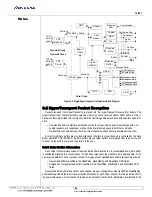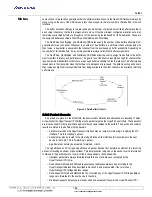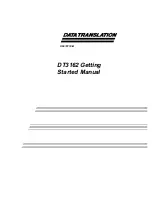
*Notice: The information in this document is subject to change without notice
About This Manual
Notes
Tsi301 HyperTransport to PCI User Manual
6
Signals and Bits
•
Active-Low Signals—Signal names ending in _N, such as SFILL_N, indicate active-low signals.
Active-low signals are asserted in their low-voltage state and negated in their high-voltage state.
•
Active-High Signals are asserted in their high-voltage state and negated in their low-voltage state.
•
Differential Signals—Differential signals are indicated by the _H and _L suffixes. Signals ending in _H
are the active-high half of a differential pair whereas signals ending in _L are the active-low half of a
differential pair.
•
Signal Ranges—The highest and lowest signal numbers in a range of signals are contained in
brackets and separated by a colon; for example D[63:0].
•
Reserved Bits and Signals—Signals or bus bits marked reserved must be driven inactive or left
unconnected, as indicated in the signal descriptions. These bits and signals are reserved by API
NetWorks, Inc. for future implementations. When software reads registers with reserved bits, the
reserved bits must be masked. When software writes such registers, it must first read the register and
change only the non-reserved bits before writing back to the register.
Data
The following list defines data terminology:
•
Quantities
–
A
word
(W) is two bytes (16 bits).
–
A
doubleword
(DW) is four bytes (32 bits).
–
A
quadword
(QW) is eight bytes (64 bits).
•
Abbreviations—The following notation is used for bits and bytes:
–
Kilo—K, as in 4-Kbyte page (2
10
).
–
Mega—M, as in 4 Mbits/sec (2
20
).
–
Giga—G, as in 4 Gbytes of memory space (2
30
).
•
Little-Endian Convention—The byte with the address xx...xx00 is in the least-significant byte position
(little end). In byte diagrams, bit positions are numbered from right to left: The little end is on the right,
and the big end is on the left.
•
Bit Ranges—In text, bit ranges are shown with a colon (for example, 3:0). When accompanied by a
signal or bus name, the highest and lowest bit numbers are contained in brackets and separated by a
colon (for example, AD[31:0]).
•
Bit Values—Bits can either be set to 1 or cleared/reset to 0.
•
Hexadecimal and Binary Numbers—Unless the context makes interpretation clear, hexadecimal
numbers are followed by an
h
, binary numbers are followed by a
b
, and decimal numbers are followed
by a
d
.
Acronyms
The following is a list of acronyms used in this document.
Acronym
Definition
APIC
Advanced Programmable Interrupt Controller
BIOS
Basic Input/Output System
CSR
Control/Status Register
DAC
Dual Address Cycle
DDR
Double Data Rate
DMA
Direct Memory Access
DRAM
Direct Random Access Memory
ESBGA
Enhanced Super Ball Grid Array
FIFO
First In, First Out
HSTL
High-Speed Transistor Logic
I/O
Input/Output





































